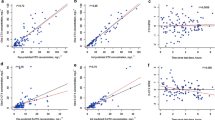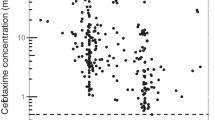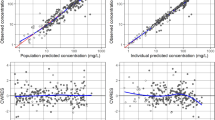Abstract
Purpose
To assess ceftriaxone population pharmacokinetics in a large pediatric population and describe the proper dose for establishing an optimized antibiotic regimen.
Methods
From pediatric patients using ceftriaxone, blood samples were obtained and the concentration was measured using high-performance liquid chromatography ultraviolet detection. The NONMEM software program was used for population pharmacokinetic analysis, for which data from 99 pediatric patients (2 to 12 years old) was collected and 175 blood concentrations were obtained.
Results
The best fit with the data was shown by the one-compartment model with first-order elimination. According to covariate analysis, weight had a significant impact on the clearance of ceftriaxone. Using Monte Carlo simulation, in a pediatric population with community-acquired pneumonia, a dose regimen of 100 mg/kg every 24 h produced satisfactory target attainment rates while remaining within the required minimum inhibitory concentration (2 mg/L).
Conclusion
Population pharmacokinetics of ceftriaxone was evaluated in children and an optimum dosing regimen was constructed on the basis of the pharmacokinetics-pharmacodynamics model-based approach.



Similar content being viewed by others
References
Clark JE, Hammal D, Hampton F, Spencer D, Parker L (2007) Epidemiology of community-acquired pneumonia in children seen in hospital. Epidemiol Infect 135(2):262–269
Lim WS, Baudouin SV, George RC, Hill AT, Jamieson C, Jeune IL et al (2009) Pneumonia guidelines committee of the BTS standards of care committee. Thorax 64, Suppl 3: iii1-iii55
Jain S , Self WH, Wunderink RG, Fakhran S, Balk R, Bramley AM et al (V) Community-acquired pneumonia requiring hospitalization among U.S. adults. N Engl J Med 373:415–427
Hui L, Xincai X, Lu J, Zongxi C, Luo L, Yang Z (2013) Epidemiological characteristics and etiology of community-acquired pneumonia in Guangzhou from 2009 to 2012. Chinese J Prevent Med 47(12):1089–1094
Liu L, Oza S, Hogan D, Chu Y, Perin J, Zhu J, Lawn JE, Cousens S, Mathers C, Black RE (2016) Global, regional, and national causes of under-5 mortality in 2000-15: an updated systematic analysis with implications for the sustainable development goals. Lancet 388(10063):3027–3035
Lamb HM, Ormrod D, Scott LJ, Figgitt DP (2002) Ceftriaxone: an update of its use in the management of community-acquired and nosocomial infections. Drugs 62(7):1041–1089
Cabellos C, Viladrich PF, Verdaguer R, Pallares R, Liñares J, Gudiol F (1995) A single daily dose of ceftriaxone for bacterial meningitis in adults: experience with 84 patients and review of the literature. Clin Infect Dis 20(5):1164–1168
Brogden RN, Ward A (1988) Ceftriaxone. A reappraisal of its antibacterial activity and pharmacokinetic properties, and an update on its therapeutic use with particular reference to once-daily administration. Drugs 35(6):604–645
Yuk JH, Nightingale CH, Quintiliani R (1989) Clinical pharmacokinetics of ceftriaxone. Clin Pharmacokinet 17(4):223–235
Stoeckel K, McNamara PJ, Brandt R, Plozza Nottebrock H, Ziegler WH (1981) Effects of concentration-dependent plasma protein binding on ceftriaxone kinetics. Clin Pharmacol Ther 29:650–657
Stoeckel K, Koup JR (1984) Pharmacokinetics of ceftriaxone in patients with renal and liver insufficiency and correlations with a physiologic nonlinear protein binding model. Am J Med 77(4C):26–32
McNamara PJ, Gibaldi M, Stoeckel K (1983a) Volume of distribution terms for a drug (ceftriaxone) exhibiting concentration-dependent protein binding. I Theoretical considerations. Eur J Clin Pharmacol 25:399–405
McNamara PJ, Gibaldi M, Stoeckel K (1983b) Volume of distribution terms for a drug (ceftriaxone) exhibiting concentration-dependent protein binding. II Physiological significance. Eur J Clin Pharmacol 25:407–412
Grubbauer HM, Dornbusch HJ, Dittrich P, Weippl G, Mutz I, Zobel G, Georgopoulos A, Fotter R (1990) Ceftriaxone monotherapy for bacterial meningitis in children. Chemotherapy 36:441–447
Steele RW, Eyre LB, Bradsher RW, Weinfeld RE, Patel IH, Spicehandler J (1983) Pharmacokinetics of ceftriaxone in pediatric patients with meningitis. Antimicrob Agents Chemother 23:191–194
Fukumoto K, Aida S, Oishi T, Ueno K (2009) Pharmacokinetics of ceftriaxione, a third-generation cephalosporin, in pediatric patients. Biol Pharm Bull 32:1139–1141
Schaad UB, Hayton WL, Stoeckel K (1985) Single-dose ceftriaxone kinetics in the newborns. Clin Pharmacol Ther 37:522–528
Chadwick E, Yogev R, Shulman S, Weinfeld R, Patel I (1983) Single dose ceftriaxone pharmacokinetics in pediatric patients with central nervous system infections. J Pediatr 102:134–137
Del Rio M, MacCracken G, Nelson J, Chrane D, Shelton S (1982) Pharmacokinetics and cerebrospinal fluid bactericidal activity of ceftriaxone in the treatment of pediatric patients with bacterial meningitis. Antimicrob Agents Chemother 22:622–627
Standing JF, Anderson BJ, Holford NH, Lutsar I, Metsvaht T (2015) Comment on pharmacokinetic studies in neonates: the utility of an opportunistic sampling design. Clin Pharmacokinet 54:1287–1288
Isla A, Trocóniz IF, Canut A, Abora A, Martín-Herrero JE, Pedraz J, et al (2011) Evaluación farmacocinética/far-macodinámica de agentes antimicrobianos para el tratamiento de la otitis media aguda en España. Enferm Infecc Microbiol Clin 29:167–173
Mullholland S, Gavranich J, Chang AB (2010) Antibiotics for community-acquired lower respiratory tract infections secondary to Mycoplasma pneumoniae in children. Cochrane Database Syst Rev 7(7):CD004875
Fukumoto K, Aida S, Oishi T, Ueno K (2009) Pharmacokinetics of ceftriaxione, a third-generation cephalosporin, in pediatric patients. Biol Pharm Bull 32(7):1139–1141
Sharland M (2016). Manual of childhood infection, the blue book. 912 Pages ISBN: 9780198729228. Oxford Specialist Handbooks in Pediatrics
Gary P. Wormser, Roger G. Faix. 2007. Red book: 2006 report of the Committee on Infectious Diseases, 27th Edition Edited by Larry K. Pickering, Carol F. Baker, Sarah S. Long, and Julia A. McMillan Elk Grove Village, IL: American Academy of Pediatrics, 2006. 992 pp. $124.95 (cloth), Clinical infectious diseases. 44. 892–892
AHFS drug information essentials. Bethesda, MD (2004) American Society of Health-System Pharmacists
Helen K (2015). The Harriet Lane handbook: a manual for pediatric house officers, 17th edition, Philadelphia, PA 19103-2899, ISBN: 978-0-323-39955-5
BNF for children 2016-2017. (2016). 1st ed. London: BMJ Group, Pharmaceutical Press and RCPCH Publications Ltd.
Drugs.com [Internet]. Ceftriaxone information from Drugs.com; Dec 12, 2017 https://www.drugs.com/dosage/ceftriaxone.html
Athenahealth, Inc. [US] https://online.epocrates.com/drugs/162302/ceftriaxone/Peds-Dosing
Hooker AC, Staatz CE, Karlsson MO (2007) Conditional weighted residuals (CWRES): a model diagnostic for the FOCE method. Pharm Res 24:2187–2197
Verdier M-C, Tribut O, Tattevin P, Le Tulzo Y, Michelet C, Bentué-Ferrer D (2011) Simultaneous determination of 12 beta-lactam antibiotics in human plasma by high-performance liquid chromatography with UV detection: application to therapeutic drug monitoring. Antimicrob Agents Chemother 55:4873–4879
Lindbom L, Ribbing J, Jonsson EN (2004) Perl-speaks-NONMEM (PsN): a Perl module for NONMEM related programming. Comput Methods Prog Biomed 75:85–94
Comets E, Brendel K, Mentré F (2008) Computing normalised prediction distribution errors to evaluate nonlinear mixed-effect models: the npde add-on package for R. Comput Methods Prog Biomed 90:154–166
Craig WA (1998) Pharmacokinetic/pharmacodynamic parameters: rationale for antibacterial dosing of mice and men. Clin Infect Dis 26:1–10
Craig WA (1995) Interrelationship between pharmacokinetics and pharmacodynamics in determining dosage regimens for broad-spectrum cephalosporins. Diagn Microbiol Infect Dis 22:89–96
EUCAST (2019) Antimicrobial susceptibility testing. Clinical breakpoints— bacteria (v 9.0)
McNamara PJ, Trueb V, Stoeckel K (1990) Ceftriaxone binding to human serum albumin. Indirect displacement by probenecid and diazepam. Biochem Pharmacol 15:1247–1253
Garot D, Respaud R, Lanotte P, Simon N, Mercier E, Ehrmann S, Perrotin D, Dequin P-F, Le Guellec C (2011) Population pharmacokinetics of ceftriaxone in critically ill septic patients: a reappraisal. Br J Clin Pharmacol 72:758–767
Leroux S, Turner MA, Barin-Le Guellec C, Hill H, van den Anker JN, Kearns GL, Jacqz-Aigrain E, Zhao W (2015) Pharmacokinetic studies in neonates: the utility of an opportunistic sampling design. Clin Pharmacokinet 54:1273–1285
Barker CIS, Germovsek E, Hoare RL, Lestner JM, Lewis J, Standing JF (2014) Pharmacokinetic/pharmacodynamic modelling approaches in paediatric infectious diseases and immunology. Adv Drug Deliv Rev 73:127–139
Jacobs MR (2001) Optimization of antimicrobial therapy using pharmacokinetic and pharmacodynamic parameters. Clin Microbiol Infect 7:589–596
Craig WA (2001) Does the dose matter? Clin Infect Dis 33(Suppl 3):S233–S237
MacGowan A (2004) Elements of design: the knowledge on which we build. Clin Microbiol Infect 0:6–11, 10
Ohno A, Ishii Y, Kobayashi I, Yamaguchi K (2007) Antibacterial activity and PK/PD of ceftriaxone against penicillin-resistant Streptococcus pneumoniae and beta-lactamase-negative ampicillin-resistant Haemophilus influenzae isolates from patients with community-acquired pneumonia. J Infect Chemother 13(5):296–301
Ren X, Liu D, Ding N, Huang K, Xiong Y, Du G, Zeng F (2012) Safety evaluation of cephalosporins based on utilization and adverse drug events: analysis of two databases in China. Expert Opin Drug Saf 11:689–697
Tod M, Jullien V, Pons G (2008) Facilitation of drug evaluation in children by population methods and modelling. Clin Pharmacokinet 47:231–243
European Medicines Agency (2009) Guideline on the investigation of medicinal products in the term and preterm neonate. European Medicines Agency, London, United Kingdom http://www.ema.europa.eu/docs/en_GB/document_library/Scientific_guideline/2009/09/WC500003750.pdf
Funding
This work was supported by the National Science and Technology Major Projects for “Major New Drugs Innovation and Development” (2017ZX09304029-002, 2017ZX09304029-005), Scientific Research Foundation for the High-Level Returned Overseas Chinese Scholars (Ministry of Human Resources and Social Security, CG2016030001) and Hundred-Talent Program (The People’s Government of Hebei Province, E2015100010), Young Taishan Scholars Program of Shandong Province, Qilu Young Scholar Program of Shandong University, and Science and Technology Planning Project of Hebei Province (15277705D), We declare that we have no conflicts of interest relevant to this article.
Author information
Authors and Affiliations
Contributions
LYT, BPX, ADS, EJA, and WZ designed the study; YKW, YEW, and LYT organized the trial and recruited patients; MK, YZ, and HYS set up the analytical method; MWK, BHT, and WZ performed PK analysis; MWK, YKW, LYT, and WZ drafted the first version of the manuscript and it was critically reviewed by all the other authors.
Corresponding author
Ethics declarations
Conflict of interest
The authors declare that they have no competing interests.
Ethical approval
This study was conducted at the Children’s Hospital of Hebei Province and was approved by the ethics board of the Children’s Hospital of Hebei Province affiliated to Hebei Medical University. This study was also registered at ClinicalTrials.gov (NCT03113344).
Additional information
Publisher’s note
Springer Nature remains neutral with regard to jurisdictional claims in published maps and institutional affiliations.
Rights and permissions
About this article
Cite this article
Khan, M.W., Wang, YK., Wu, YE. et al. Population pharmacokinetics and dose optimization of ceftriaxone for children with community-acquired pneumonia. Eur J Clin Pharmacol 76, 1547–1556 (2020). https://doi.org/10.1007/s00228-020-02939-4
Received:
Accepted:
Published:
Issue Date:
DOI: https://doi.org/10.1007/s00228-020-02939-4




